by Daniel J. Leonard | Jul 3, 2018
Each time I travel to central and south Florida and observe the wonderfully flamboyant tropical flora, I am reminded of the unique and frustrating climatic characteristics of Northwest Florida. Our weather is tropical enough through the summer to sustain virtually everything our friends to the south grow, but winters north of the Big Bend are just cold enough to prevent long-term success with most tropical species. However, the genus that is maybe most synonymous with tropical color, the Hibiscus (it even has its own texting emoji!), contains several species that are hardy through our winters. The best landscape plant of these hardy Hibiscus species is creatively (sarcasm) called Hardy Hibiscus or Giant Rose Mallow (Hibiscus moscheutos) and is an absolute star in the Panhandle, bringing the beauty of the tropics to your yard!
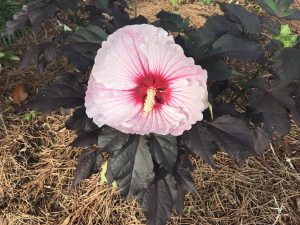
Hibiscus ‘Starry Starry Night’ – Photo courtesy Daniel Leonard
Rose Mallow is a native perennial species that occurs in sunny wetlands across the eastern U.S. This species can grow 7-8’ in height in its natural, unimproved state and possesses the largest flowers of any hardy perennial, some varieties easily eclipse 12” in diameter. Rose Mallows bloom through the heat of our long summers and return reliably each winter unfazed by frost. The flowers also happen to be a favorite of butterflies and hummingbirds and bring beneficial wildlife to the landscape. These characteristics and the trend towards the use of pollinator friendly, low-maintenance native perennials in landscapes quickly made Rose Mallow a jewel for plant breeders and now virtually all major horticultural brands have a line of Hardy Hibiscus available at garden centers, in varying sizes, flower color and leaf color/form. Recent breeding efforts have focused on introducing plants with enormous, richly colored flowers held on compact plants with attractive foliage. The results have yielded two series and three individual cultivars that I consider superior selections and are more than worthy of inclusion in your garden:
- Summerific® Series by Proven Winners. This series is comprised of four robust (up to 5’ in height) cultivars, ‘Cherry Cheesecake’ (bicolor magenta and white flowers), ‘Berry Awesome’ (purplish lavender flowers), ‘Cranberry Crush’ (a red you really have to see to believe), and ‘Perfect Storm’ (notable for its deep purple foliage).
- Luna Series by Monrovia. This series is notable for its ultra-compact (3’ in height or less) size and characteristically large flowers. It is also composed of four cultivars, ‘Luna Red’ (deep red), ‘Luna Blush’ (white, fading to pink near flower margins), ‘Luna Pink Swirl’ (pictured and my favorite, bicolor swirly flowers), and ‘Luna White’ (white with a red center).
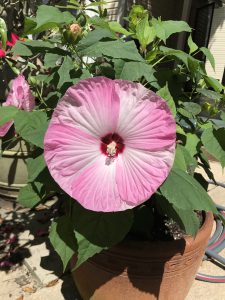
Hibiscus ‘Luna Pink Swirl’ – Photo courtesy Daniel Leonard
- ‘Starry Starry Night’ by Walter’s Gardens. (Pictured) This cultivar combines dark purple to black leaves with swirled pale and dark pink flowers. It has performed very well in my landscape and if I could only grow one, this might be it.
- ‘Lord Baltimore.’ The classic, large growing cultivar with bright red flowers that is widely available and easily found. An oldie (introduced in 1955) but a goodie.
- ‘Midnight Marvel’ by Walter’s Gardens. A “hot off the press” new cultivar that is currently difficult to find due to popularity, though some online outlets have them available in small sizes. This one is worth your patience. Sporting deep red blooms on near black foliage, there’s nothing else like it in the landscape.
In addition to being gorgeous plants, Rose Mallows are extremely versatile in the landscape and could not be easier to grow. Because the size varies so greatly (from the diminutive 30” tall ‘Luna’ series to the 8’ tall unimproved species), there really is a place for one in every garden. I like to use the smaller cultivars in large containers to facilitate moving them around where their floral display has the greatest impact or to create a tropical effect where in ground plantings are not an option (pool decks, patios, etc). The larger cultivars make spectacular specimen plantings in perennial and shrub beds and even make a really dense, striking hedge (just know they disappear in the winter). Be sure to give them as much sun as possible, as this will enhance the number of flowers on each plant and darken the foliage on the cultivars with purplish/black leaves. Too little sun will result in fewer flowers and lighter green foliage. As wetland plants, Rose Mallows enjoy regular water, either from rainfall or irrigation; they will let you know when they need it – their large leaves readily wilt under drought stress, somewhat like Hydrangea.
For low-maintenance, native, pollinator friendly, cold-hardy tropical color, you need look no further than Rose Mallow. These perennial shrubs come in all sizes and colors and fit any landscape! Look for the above listed series and cultivars at better garden centers and online retailers and enjoy the oohs and ahhs elicited when people first get a glimpse of Hardy Hibiscus in your landscape! Happy Gardening!
by Matt Lollar | Jun 21, 2018
Are you interested in growing squash in your garden? Do you know the difference between summer squash and winter squash? Check out this very informative instructional video on growing squash in your home garden by Walton County Agriculture Agent Evan Anderson.
[youtube https://www.youtube.com/watch?v=hlbJfV-0FuU&w=560&h=315]
by Ray Bodrey | Jun 7, 2018
Camellias are a Panhandle favorite, as the flowers can highlight a landscape with bright, vibrant colors in fall and winter. However, spring time can bring about these colors in a negative way, in the form of leaf gall.
The camellia is native to Asia and brought to America in the late 1700’s. These plants have proven to be a dependable addition to the southern landscape with minimal care. When camellias are correctly planted and cared for, minimal disease problems arise. However, camellias can contract leaf spot, dieback, root rot and bud and leaf gall.
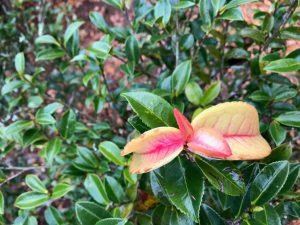
Camellia Gall Credit: Patty Dunlap, Gulf County Master Gardener.
Leaf and bud galls are caused by the fungus Exobasidium vaccinia. The gall appears as thickened, waxy and enlarged leaves or buds during the cool spring months. One or several leaves on a single shoot may be affected. Once you’ve found infected leaves, no chemical control will be effective. Actually, no fungicide has been found very effective in combatting this condition. However, control can be accomplished in the home garden by simply pinching off and destroying infected leaves. Disease activity usually stops with warmer weather. A best management practice to curb infection is to reduce overhead watering during cool, wet weather periods of spring. Great news, this condition does not cause any long-term issues with the plant.
For more information regarding fungal issues in landscape plants, contact your local county extension office.
Fun camellia fact: The young leaves of the species, Camellia sinensis, are processed for tea, one of the world’s most popular drinks. Please see UF/IFAS EDIS publication, “Tea Growing in the Florida Landscape” by Jonathan H. Crane and Carlos F. Balerdi: http://edis.ifas.ufl.edu/pdffiles/HS/HS30800.pdf
Supporting information for this article can be found in the UF/IFAS EDIS publication, “Camellias at a Glance” by Sydney Park Brown: http://edis.ifas.ufl.edu/pdffiles/EP/EP00200.pdf
UF/IFAS Extension is an Equal Opportunity Institution.
by Mary Salinas | May 23, 2018
A healthy lawn is a joy to stroll, relax and play on. It can also be part of an environmentally friendly landscape. But, sometimes it can seem to be a mystery on how to achieve that lush, healthy lawn in the Florida environment. Since we have lots of sandy soils and experience long periods of warm and hot weather, many suppose that giving the lawn lots of water will help do the trick. Not so.
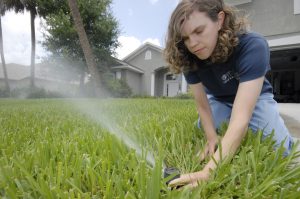
Photo credit: UF/IFAS.
But what harm can it cause to give the lawn plenty of water all the time? Isn’t that a good thing? No! Overwatering your lawn can lead to the following problems:
- Development of fungal diseases (fungi love a moist environment!)
- Increased insect pest pressure
- More rapid thatch development
- More weeds (those little emerging weed seedlings thrive on consistent moisture!)
- Some weeds, like dollarweed and sedges, can be an indication of overwatering
- A shallow root system when frequent, light watering is applied
- Washing away of fertilizer down into the soil past the root system
- Higher water bills.
Our lawns need, on average, about 1/2 to 3/4 “of water a week during the summer. This recommendation changes depending on soil type, shade, temperature, wind, and season. To figure out how long to run your sprinklers, watch this YouTube video from UF/IFAS.
We recommend running your automated system only when your lawn shows signs of needing water such as:
- Leaf blades fold
- The lawn looks ‘off-color’
- Footprints remain and are visible
For more information:
Watering Your Florida Lawn
Gardening Solutions: Irrigation
Your Florida Lawn

by Sheila Dunning | Apr 9, 2018
 This month, recognized by the Senate and Florida’s governor, reminds diggers why calling 811 before all outdoor digging projects is important to your safety. Before installing a mailbox, fence, deck, garden or tree make sure to call Sunshine 811 to have underground lines marked. 811 is the free national number designated by the Federal Communications Commission. It notifies utility companies, who in turn send their professional locators to identify and mark the appropriate location of underground line with paint and flags in colors that identify the utility type. The following colors represent the seven various utilities: red, orange, blue, green, yellow, purple and white. To see which colors correspond with each utility go to: http://www.call811.com/faqs/default.aspx.
This month, recognized by the Senate and Florida’s governor, reminds diggers why calling 811 before all outdoor digging projects is important to your safety. Before installing a mailbox, fence, deck, garden or tree make sure to call Sunshine 811 to have underground lines marked. 811 is the free national number designated by the Federal Communications Commission. It notifies utility companies, who in turn send their professional locators to identify and mark the appropriate location of underground line with paint and flags in colors that identify the utility type. The following colors represent the seven various utilities: red, orange, blue, green, yellow, purple and white. To see which colors correspond with each utility go to: http://www.call811.com/faqs/default.aspx.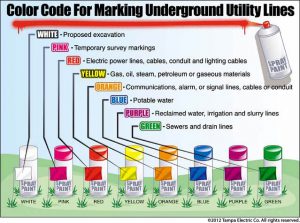
Hitting an underground utility line while digging can cause injuries, utility service outages to an entire neighborhood and damage to the environment. Failure to call before digging results in one unintentional utility hit every eight minutes nationwide. You could also be financially affected with costly fines and high repair costs.
Calling 811 in Florida is the law. At least two full business days before digging, do-it yourselfers and professional excavators must contact 811 by phone to start the process of getting underground utility lines marked. This is a free service. Be sure that all utilities have been marked before grabbing the shovel. Follow up on your one call ticket by contacting 811 again on the third day. For more information on Florida’s law, visit www.Sunshine811.com.
by Les Harrison | Aug 11, 2017
July’s hot summer weather has given way to August’s 31 days of what will likely be temperatures and humidity equally elevated and intense. Wishes for November’s cooler thermometer reading are already creeping into daily conversations. The lawns and gardens in Wakulla County have rains as a mitigating factor to counteract the wilting potential of normal to excessive temperature readings. Unfortunately the arrival of water from above is not on a set or easily predictable schedule.
Traditionally, summer is the wettest season in Florida, with more than half of the annual rainfall occurring during the June to September “wet season”. Florida’s highest average annual rainfall occurs in the Panhandle with averages exceeding 60 inches per year. The Pensacola and Tallahassee weather stations are listed among the ten “wettest” stations in the nation. Still, this pattern of seasonal precipitation can vary greatly between locations, years and even days. This variability often results in the need to water the lawn, landscape and garden. By following a few guidelines, you can produce the best results for plants under stress and conserve a vital and limited resource.
It is most efficient to apply water between 5:00 a.m. and 10:00 a.m. for several reasons. Only water that is in contact with roots can be absorbed by the plant. If water is applied after 10:00 a.m., a substantial portion of it will evaporate before it reaches the roots; more will then need to be applied and this resource’s productivity will be reduced. Never water late in the afternoon as evaporation will still be a problem, and wet turf and plants will invite a variety of fungal diseases to flourish as night settles.
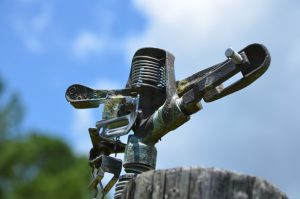
Photo Courtesy: Les Harrison, UF/IFAS Wakulla County Extension
In the case of landscapes and gardens, water should be applied only when the moisture in the root zone system has been depleted to an unacceptable level, usually by 1/2 to 2/3 of the stored soil-water. There are several ways to determine when the soil-water reservoir has been depleted beyond an acceptable level. The simplest method is a visual inspection of the turf or plants. Common symptoms of water stress include leaf color changes to a bluish-gray tint, footprints which linger long after being pressed into the grass and curled or folded leaf blades. Be sure the sprinklers are delivering water to the target area as water which misses the soil and is applied to hard surfaces such as driveways and sidewalks will be wasted. It also may pose an environmental problem in the form of runoff. Surface runoff that flows past the landscape will usually reach streams, ponds, or the Gulf of Mexico. If it picks up pollutants along the way, they too will reach the surface water bodies.
Over watering can be just as damaging as too little water. Excessive irrigation water can infiltrate the ground and reach groundwater aquifers. This issue is complicated when groundwater runs close to the surface. Excessive nutrients or pollutants can be discharged into surface bodies or move vertically into the deeper land layers. The connected springs and sinkholes in Wakulla County make the movement of surface water a common concern. Responsible and efficient irrigation will have positive effects far beyond the front yard.
To learn more about the effective use of water in Wakulla County’s landscapes, contact your UF/IFAS Wakulla Extension Office at 850-926-3931 or http://wakulla.ifas.ufl.edu/







